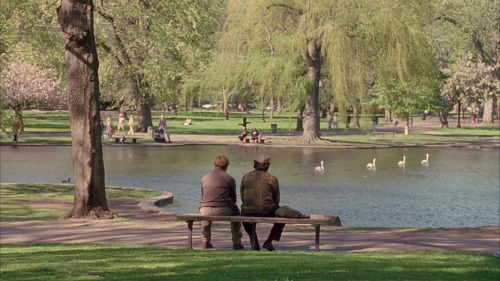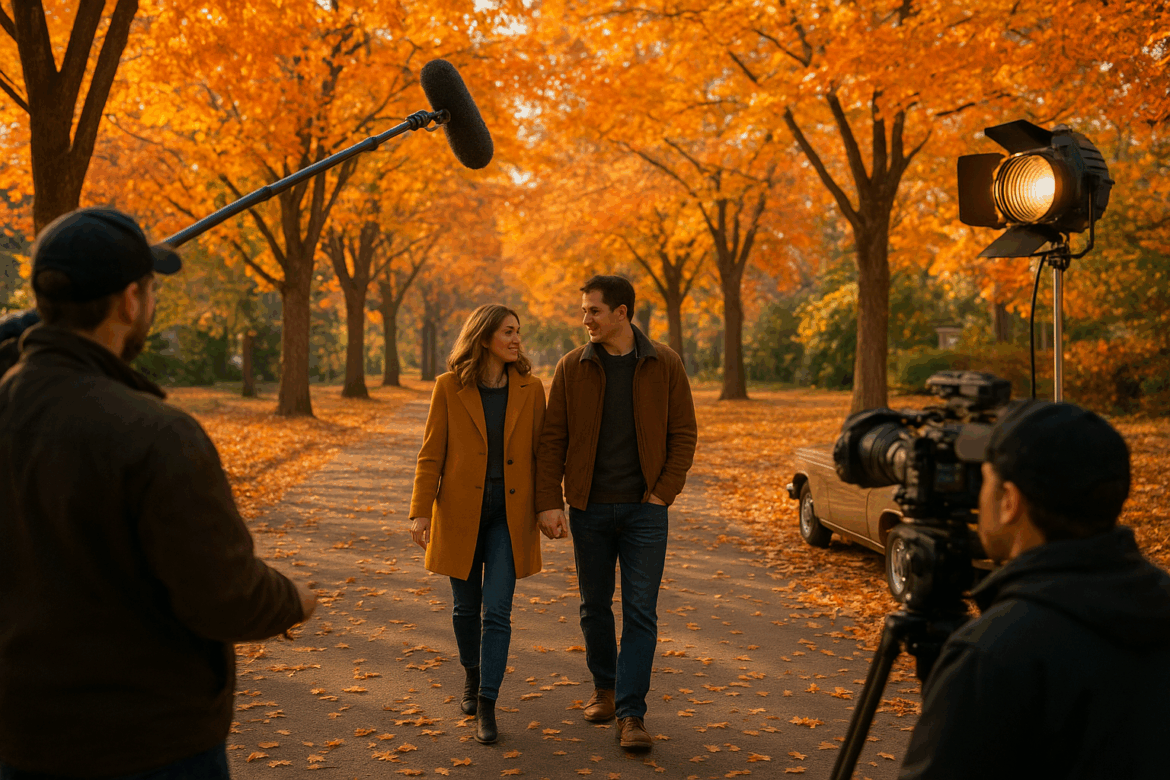While spring gets the credit for renewal and summer dominates blockbuster release schedules, the fall season quietly reigns as one of Hollywood’s most valuable filming periods. From the warm, honeyed light that photographers dream about to the dramatic transformation of landscapes, autumn film locations offer cinematographers and location scouts a unique palette that can make even the simplest scenes unforgettable.
If you’re a property owner, location scout, or filmmaker wondering why your phone starts ringing more in September, here’s why the fall season has become the film industry’s secret weapon for securing stunning film locations.
The Magic of Fall Season Lighting for Film Locations
Ask any cinematographer about their favorite time to shoot autumn film locations, and many will point to those crisp October afternoons when the sun hangs lower in the sky, casting everything in a golden glow that no amount of artificial lighting can replicate.
The Science Behind the Beauty During the fall season, the sun’s angle creates longer, more dramatic shadows while filtering through atmosphere that often contains more moisture and particles, resulting in that coveted “golden hour” effect lasting longer throughout the day. This natural lighting makes autumn film locations particularly flattering for outdoor dialogue scenes, romantic moments, and establishing shots that need to convey warmth and intimacy.
Reduced Lighting Equipment Needs Film locations during the fall season can achieve cinematic lighting with minimal equipment. The soft, warm natural light reduces the need for extensive grip and electric setups, saving both time and budget while often producing more beautiful results than artificial alternatives.
Nature’s Built-In Production Design for Autumn Film Locations
The fall season transforms ordinary film locations into cinematic gold mines. A suburban street becomes a picturesque autumn wonderland, while rural properties take on the romantic appeal of a Norman Rockwell painting.
Color Palette Perfection The natural color grading that the fall season provides – deep reds, golden yellows, burnt oranges, and rich browns – creates visual interest in film locations without requiring post-production color correction. These warm tones are particularly effective for:
- Romantic comedies and dramas
- Coming-of-age stories
- Family-centered narratives
- Nostalgic period pieces
Texture and Movement Falling leaves provide natural movement in frame, while bare branches create interesting silhouettes and patterns. Wind rustling through autumn foliage adds natural sound design that enhances the atmosphere without requiring additional audio work.
Practical Production Advantages
Beyond the aesthetic benefits, fall offers several practical advantages that smart productions have learned to exploit.
Comfortable Weather Conditions
Fall temperatures are ideal for crew comfort and equipment performance. Unlike summer’s sweltering heat or winter’s harsh conditions, autumn weather allows for longer shooting days with fewer weather delays.
Extended Shooting Windows
The mild temperatures and stable weather patterns common in fall mean productions can often shoot from early morning through evening without major concerns about extreme weather, maximizing their location rental value.
Tourist Season Transitions
Many prime filming locations see reduced tourist traffic in fall, making it easier to secure permits, control crowds, and negotiate better rates for extended shoots.
Iconic Fall Scenes That Defined Movies
Some of cinema’s most memorable moments have been enhanced by autumn’s natural beauty:
“When Harry Met Sally” (1989) utilized New York’s Central Park in fall to create romantic atmosphere during the famous “I love you” scene. The golden leaves and soft lighting made the emotional climax feel both intimate and epic.

“Good Will Hunting” (1997) famously used Boston’s fall foliage to underscore the themes of change and growth, with the Harvard and MIT campuses looking particularly stunning in their autumn colors.

“You’ve Got Mail” (1998) built much of its cozy, romantic atmosphere around New York City’s fall season, using the changing leaves and warm lighting to create the perfect backdrop for a modern romance.

“Dead Poets Society” (1989) shot extensively during Vermont’s fall season, using the dramatic autumn colors to enhance the film’s themes of inspiration and transformation.
Maximizing Your Property’s Fall Appeal
If you own a filming location, here’s how to capitalize on autumn’s cinematic advantages:
Timing is Everything
The peak fall foliage season varies by location but generally runs from late September through early November. Market your property’s availability during these crucial weeks when the natural beauty is at its peak.
Highlight Natural Features
Emphasize trees, gardens, and outdoor spaces in your location marketing during fall months. Properties with mature trees, scenic views, or interesting landscapes become significantly more valuable during autumn.
Flexible Scheduling
Be prepared for last-minute bookings during fall, as productions often make location decisions based on weather forecasts and foliage reports. The ability to accommodate quick turnarounds can command premium rates.
Seasonal Photography
Update your location photos each fall to showcase how your property looks during peak autumn conditions. These seasonal shots can attract bookings throughout the year from productions planning ahead.
The Economics of Fall Filming
Productions understand that fall’s natural advantages can save significant money in other areas:
- Reduced Lighting Costs: Natural fall light often eliminates the need for expensive lighting setups
- Minimal Set Decoration: Autumn’s natural beauty reduces the need for extensive location dressing
- Weather Reliability: Fall’s stable weather patterns reduce the risk of costly weather delays
- Extended Golden Hours: Longer periods of optimal lighting mean more usable shooting time per day
Planning Ahead for Peak Season
Smart location owners and production companies start planning fall shoots months in advance. The combination of ideal weather, natural beauty, and practical advantages makes autumn one of the most competitive booking seasons for desirable filming locations.
For productions looking to book fall locations, start your search in early summer. For property owners, begin marketing your fall availability in late spring to capture productions in their early planning phases.
The Future of Fall Filming
As more productions recognize autumn’s advantages, the demand for fall-friendly locations continues to grow. Properties with strong seasonal appeal – whether it’s a New England farmhouse surrounded by maple trees or an urban location with tree-lined streets – represent increasingly valuable assets in the location rental market.
The rise of streaming content and year-round production schedules means that fall filming isn’t just limited to movies anymore. Television series, commercials, and digital content creators are all seeking to capture autumn’s magic, expanding opportunities for location owners throughout the season.
Fall doesn’t just provide beautiful backdrops – it offers productions a complete package of natural advantages that can elevate any project. For location scouts and property owners alike, understanding and leveraging autumn’s unique benefits isn’t just about capturing pretty pictures. It’s about recognizing one of nature’s most powerful tools for visual storytelling. Looking for beach locations? Check out this post.
Looking to book the perfect fall filming location? Set Scouter features hundreds of properties that showcase autumn’s natural beauty. From tree-lined estates to cozy rural retreats, find the location that captures the magic of the season.

